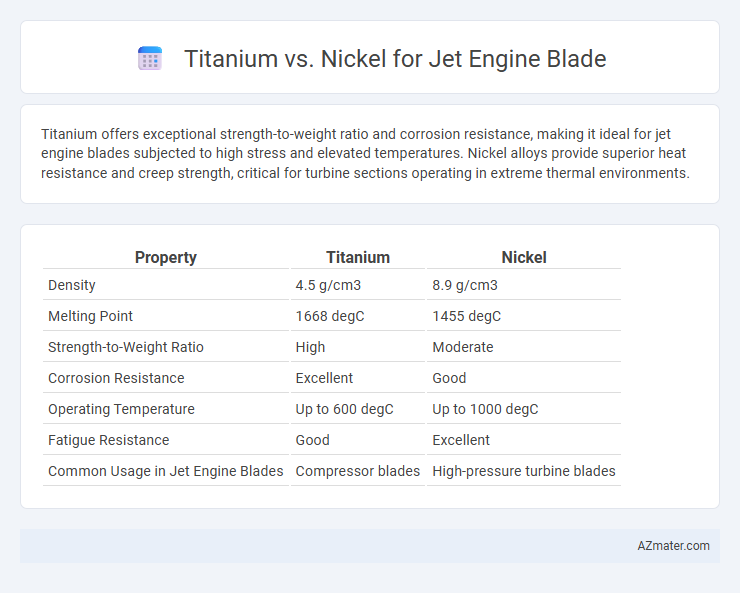Titanium offers exceptional strength-to-weight ratio and corrosion resistance, making it ideal for jet engine blades subjected to high stress and elevated temperatures. Nickel alloys provide superior heat resistance and creep strength, critical for turbine sections operating in extreme thermal environments.
Table of Comparison
| Property | Titanium | Nickel |
|---|---|---|
| Density | 4.5 g/cm3 | 8.9 g/cm3 |
| Melting Point | 1668 degC | 1455 degC |
| Strength-to-Weight Ratio | High | Moderate |
| Corrosion Resistance | Excellent | Good |
| Operating Temperature | Up to 600 degC | Up to 1000 degC |
| Fatigue Resistance | Good | Excellent |
| Common Usage in Jet Engine Blades | Compressor blades | High-pressure turbine blades |
Introduction: Importance of Material Selection in Jet Engine Blades
Material selection in jet engine blades critically influences performance, durability, and fuel efficiency. Titanium provides exceptional strength-to-weight ratio and corrosion resistance, while nickel alloys offer superior high-temperature stability and creep resistance. Choosing the appropriate material balances engine efficiency with operational lifespan under extreme thermal and mechanical stresses.
Overview of Titanium in Aerospace Applications
Titanium is widely utilized in aerospace applications due to its exceptional strength-to-weight ratio, corrosion resistance, and ability to maintain mechanical properties at high temperatures. Its low density compared to nickel alloys makes it ideal for jet engine blades where reducing weight without compromising durability is critical. Aerospace engineers favor titanium for components subjected to moderate thermal stresses, balancing performance with fuel efficiency in modern jet engines.
Overview of Nickel Alloys in Jet Engine Technology
Nickel alloys play a critical role in jet engine technology due to their exceptional high-temperature strength, corrosion resistance, and thermal stability, making them ideal for turbine blades exposed to extreme operating conditions. These superalloys maintain mechanical integrity at temperatures exceeding 1,000degC, enabling improved engine performance and fuel efficiency. Their ability to resist oxidation and creep deformation under prolonged stress differentiates them from titanium alloys, which, while lighter, are less suitable for the hottest engine sections.
Mechanical Strength: Titanium vs Nickel Alloys
Titanium alloys exhibit exceptional strength-to-weight ratios and superior fatigue resistance, making them ideal for jet engine blades that require high mechanical strength and reduced weight. Nickel-based superalloys provide outstanding high-temperature strength and creep resistance, maintaining mechanical integrity in extreme thermal environments typical of turbine sections. While titanium offers excellent mechanical performance at lower temperatures, nickel alloys dominate in sustained high-temperature applications due to their enhanced mechanical strength under thermal stress.
High-Temperature Performance Comparison
Titanium alloys offer exceptional strength-to-weight ratio and corrosion resistance but typically limit their use in jet engine blades to temperatures below 600degC due to reduced mechanical properties at higher temperatures. Nickel-based superalloys outperform titanium in high-temperature environments, maintaining structural integrity and oxidation resistance at temperatures exceeding 900degC, making them ideal for critical turbine components exposed to extreme heat. The superior creep resistance and thermal stability of nickel-based alloys ensure durability and performance in the hottest sections of jet engines, where titanium cannot sustain long-term mechanical stress.
Corrosion and Oxidation Resistance
Titanium alloys exhibit superior corrosion resistance in jet engine blades due to their stable oxide layer, which effectively protects against oxidation at moderate temperatures. Nickel-based superalloys demonstrate exceptional oxidation resistance at high temperatures, maintaining blade integrity in extreme thermal environments typical of turbine sections. Selecting between titanium and nickel depends on the operating temperature range, with titanium preferred for cooler compressor blades and nickel alloys favored for hotter turbine blades where oxidation resistance is paramount.
Weight Considerations: Density and Impact on Performance
Titanium alloys, with a density of approximately 4.5 g/cm3, offer significant weight savings compared to nickel-based superalloys, which have densities around 8.2 g/cm3, making titanium blades substantially lighter. This weight reduction directly improves jet engine performance by decreasing overall engine mass and enhancing fuel efficiency, as lighter blades reduce centrifugal loads during high-speed rotation. The lower density of titanium also allows for more flexible blade designs, contributing to better aerodynamic efficiency and increased thrust-to-weight ratios in jet engines.
Cost Analysis: Titanium vs Nickel for Manufacturing
Titanium alloys generally cost more upfront due to expensive raw materials and complex processing but offer weight savings and corrosion resistance that can reduce long-term maintenance costs. Nickel-based superalloys, while cheaper initially, provide superior high-temperature strength and durability crucial for jet engine blades operating under extreme conditions. The overall cost effectiveness depends on balancing titanium's weight and lifecycle benefits against nickel's established performance and material costs.
Advances in Material Engineering and Future Trends
Titanium alloys exhibit superior strength-to-weight ratios and corrosion resistance, making them a preferred choice for jet engine blades where weight reduction and durability are critical. Nickel-based superalloys outperform titanium in high-temperature stability and creep resistance, essential for maintaining blade integrity in the extreme thermal environments of jet engines. Future trends in material engineering focus on developing advanced titanium aluminide composites and high-entropy alloys to enhance high-temperature performance while reducing weight, potentially reshaping the material selection paradigm for next-generation jet engine blades.
Conclusion: Choosing the Optimal Alloy for Jet Engine Efficiency
Titanium alloys offer superior strength-to-weight ratio and corrosion resistance, enhancing fuel efficiency and durability in jet engine blades. Nickel-based superalloys excel in high-temperature environments, providing exceptional creep resistance and thermal stability crucial for turbine sections. Selecting the optimal alloy depends on specific engine requirements, balancing titanium's lightweight advantages with nickel's high-temperature performance to maximize overall engine efficiency.

Infographic: Titanium vs Nickel for Jet Engine Blade
 azmater.com
azmater.com